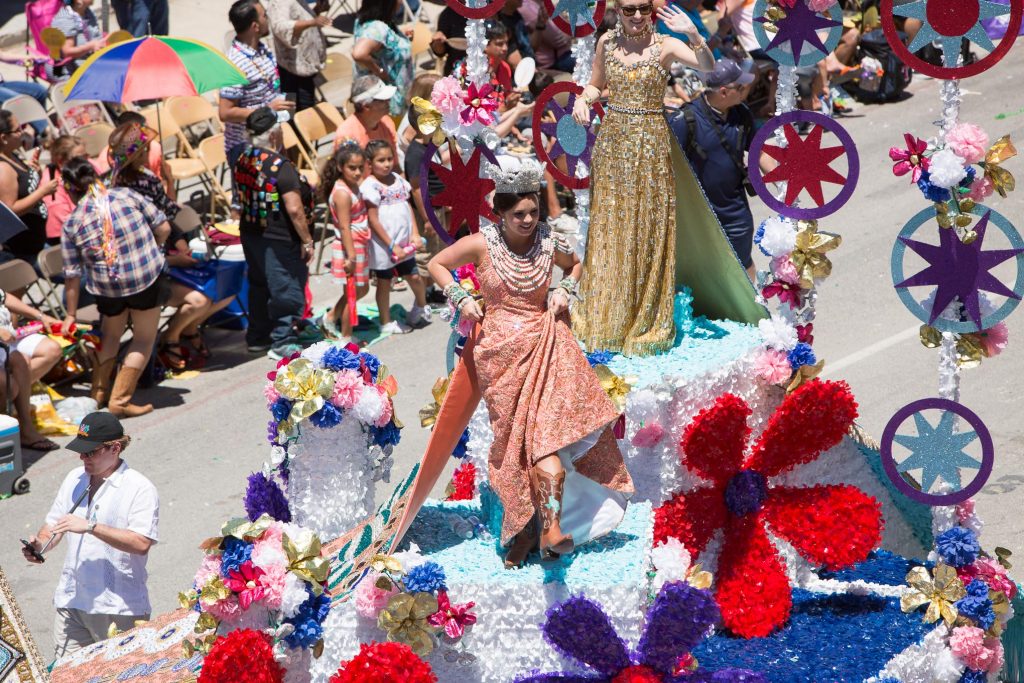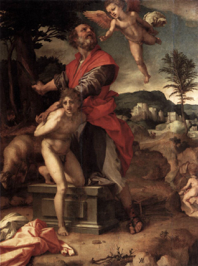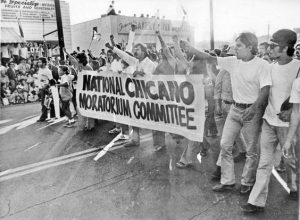Colorful floats; streets closed with barricades; people covering the sidewalks and setting up their lawn chairs to have a good view, having the day off from school; the Marching Bands from High Schools and Universities, decorating their instruments with ribbons, preparing their formation under Highway 37 on Grayson Street; the Fiesta Royalty putting on their best pairs of decorated shoes before stepping onto their throne, mounted on one of the biggest of the parade floats. If you’re a native San Antonian, you know exactly what grand celebration is about occur and what has been going on for the days before; it is part of Fiesta, the ten-day city-wide celebration; it is the Battle of Flowers parade. The Battle of Flowers is a 2.6-mile parade that runs through downtown San Antonio, typically one of the closing events of the Fiesta celebration. This Parades begins on the edge of downtown, and continues onto three major streets: Broadway, Alamo, and Commerce.1 Local schools participate in this parade; their dance troops, mariachi bands, ROTC, and Marching Band programs participate and walk the parade alongside the Texas Cavaliers, the Fiesta Royalty, and the Mayor. Although this annual event has become a hallmark for San Antonians, many don’t know how or when it all began. Let’s go back to its origins, back to the last decade of the nineteenth century in San Antonio.

Originating in 1891, the Battle of Flowers parade was created as a tribute to all those who fought and who fell at the Battles of San Jacinto and the Alamo.2 The idea of a grand celebration to commemorate these heroes came from a tourist, the native-Chicagoan W. J. Ballard. He believed that a proper tribute should be made, and asked a group of local ladies why this had not been the case just yet. His question extended through the city and made its way into newspapers and gained the approval of the community almost instantly. The anticipated idea aroused a spark of interest in Ellen Maury Slayden, a native Virginian elite, who had found her way to San Antonio by marriage to a merchant and later congressman, James L Slayden. Slayden then decided to bring Ballard’s idea to life, and since she knew it was almost impossible on her own, she decided to enlist the help of another newcomer to the area, J. S. Alexander. They both decided to take this on as a pet project of theirs, with the help and support of their husbands. Alexander, a banker before arriving in Texas, provided information on some familiarity he had had overseas about seeing a parade surrounded by flowers, where carts were decorated with flowers. Slayden also remembered similar instances in celebrations she knew about across Mexico and Spain, giving the basis for what the parade would become. The husbands, and many of the elite men of San Antonio, took over the project and had gentlemen speak on behalf of the ladies at the committee meetings; however, as the project grew, the ladies wanted to make sure that it was still a women’s project and continued to provide input and ideas, thus creating the Battle of Flowers Association.3

The parade was originally intended to be an April 21st celebration to celebrate the 55th anniversary of the victory of the Battle of San Jacinto; however, coincidentally, San Antonio was just then expecting its first-ever visit from the White House, the 23rd president of the United States, President Benjamin Harrison. As soon as word got out, the city became ecstatic and prepared a celebration to welcome the President, including moving the parade a day ahead of its original date. With the dates set in stone, the first official planning committee meeting took place only a mere seven days prior to the event. They were frantically trying to gather flowers from nearby towns, since San Antonio had just experienced some heavy rains, which had destroyed most flower gardens, leaving the city with a shortage of flowers just before the parade. Trains were rushed in with shipments of flowers from nearby towns. Other means of making up for the shortage were discussed as well, such as dressing the children up as flowers and having bicyclists decorate their mobiles with whatever blossoms they found and join the parade.4 In the days leading up to the parade, everything seemed all set to go, except for the weather. The city had been plagued with days of heavy rain, and the whole city was hopeful that the rains would cease as the day approached; however, they were wrong. On the morning of the parade, the rains didn’t have mercy on their plans, and as the President’s train arrived, the downpour became continuous. But the rains didn’t stop the city from providing the President with a warm welcome; however, it did postpone the flower parade for the following week, which, of course, would mean that the President would be long gone by then. When the warm weather finally arrived the following week, the parade went as planned; and it was so successful that the committee pushed to have it continue as an annual celebration. It has since been celebrated since 1891, except for the years during World Wars I and II.5

By 1985, the parade continued to grow into the week-long celebration known today as Fiesta. And as the years went by, Kings and Queens were elected as Fiesta Royalty.6 The Parade continues to grow, and so does its recognition across the city and the state. It is now funded by private associations. To this day the parade is one of the closing events of the city-wide, week-long Fiesta party and continues to generate community involvement. Every April, San Antonio puts on a fantastic show, and without a doubt, it all goes back to a Chicagoan tourist, two ladies, and one united community.

- Battle of Flowers, Official Website: Battle of Flowers About us (battleoflfowers.org, 2018). ↵
- Handbook of Texas, June 2010, s.v “Fiesta San Antonio,” by Mrs. Willard E. Simpson, Jr. ↵
- Jack Maguire, A Century of Fiesta in San Antonio (Austin, Texas: Eakin Press, 1990), 13-15. ↵
- Jack Maguire, A Century of Fiesta in San Antonio (Austin, Texas: Eakin Press, 1990), 17. ↵
- Jack Maguire, A Century of Fiesta in San Antonio (Austin, Texas: Eakin Press, 1990), 17; Laura Hernandez-Ehrisman, Inventing the Fiesta City, Heritage and Carnival in San Antonio (New Mexico Press,2008), 21. ↵
- Handbook of Texas, June 2010, s.v. “Fiesta San Antonio,” by Willard E. Simpson, Jr. ↵



117 comments
Kailan Pena
Being from San Antonio and experiencing fiesta I have heard of Battle of the Flowers parade but never heard the backstory behind the parade. It plays such a big part in Fiesta here in San Antonio and this article really shows and give it the credit it deserves. The crucial research that was made really made this article well informed and told me a lot about the origin of the parade.
Derek Esquivel
It is really great to see this article because of how this is just about San Antonio and how the origins of fiesta basically began. I have gone to pretty much every single parade that I can remember. It is just a great time during this time of the year because of it just great to see the floats that people make throughout the year for this special day of the year.
Alexandra Cantu
Congratulations on being nominated for Best use of Images. Your article is beautiful and the use of your pictures compliments your article perfectly. I enjoy reading about San Antonio history and you were able to help me understand the origin of Battle of the Flowers. Since I am new to San Antonio and the whole fiesta festivities im excited this article was published.
Ximena Mondragon
I’ve never been to battle of the flowers but is interesting how it all started. I never understood why it was such an important event in San Antonio since we don’t have classes however now i understand why its so important. I will make it a priority to attend this event this year since this article really got me excited for it. I love all of these traditions San Antonio has since in Houston we don’t really have traditions like this one. This article is well written and the pictures are helpful.
Erin Vento
I think that this article isn’t just well written, but its so informative in a way that the readers can use when they go to experience the Battle of the Flowers for themselves. This is my first year here, and I know that this article made me so excited for fiesta, but it also gave me something to tell family and friends when they asked about the parade or even fiesta.
Gloria Baca
Being from El Paso, I really enjoyed reading about something so valuable to the city I am currently living in. I think it is beautiful how the battle of flowers is used as a way to remember fallen soldiers. It resembles Mexican culture and extends the visuals all throughout the city. I enjoyed this article because it was a great way to familiarize myself with San Antonio culture and be aware of such an amazing parade. Great job!
Carlos Vazquez
Before coming to san Antonio last year, I had never heard of Fiesta and the Battle of the Flowers parade. This is such an important event in San Antonio and I’m surprised it’s not known all over the state. This article is really well written and informative, I really enjoyed reading it and learning more about the origins of the Battle of the flowers parade.
Esperanza Mauricio
I love learning history about San Antonio and I am quite happy with this discovery. San Antonio has also been a place of wonder for me and I have just love the city. Although I have lived in the city for 20 years as of now there is never a dull moment in the city. During Fiesta I had always wondered why we had this celebration and never knew why we did it. I’m happy to know why and how the Battle of the Flowers came to be.
Cristina Cabello
I remember when I was younger going to fiesta all the time. I really liked your title about showing their shoes. One time I at fiesta a random girl and I were yelling out, “show us your shoes!”. One of the ladies had old converses on and laughed about it when she showed us. I also did not know the history about fiesta. So that was really good to read about. Fiesta is always a good time to make memories. Overall this is a really good article.
Noah Laing
This article is certainly deserving of its “Cultural History” nomination. I really enjoyed learning more about the Battle of the Flowers and the meaning behind the parade and the flowers. This is also a great time for this article to be read as well because fiesta is taking place in San Antonio right now. I’ve live in the San Antonio area for all my life and I’ve always had a great deal of respect for the culture and atmosphere that comes with fiesta. Great article.